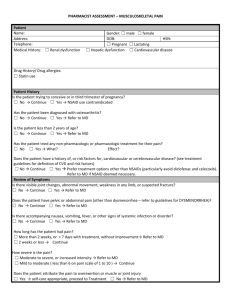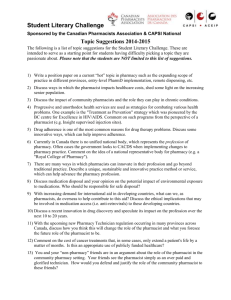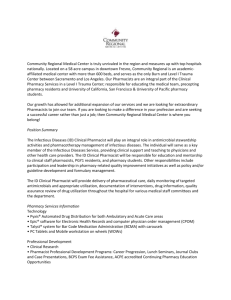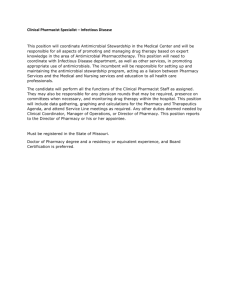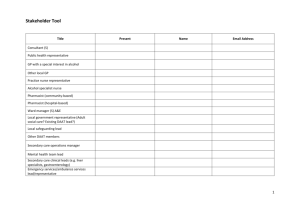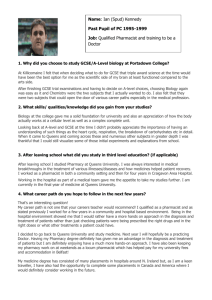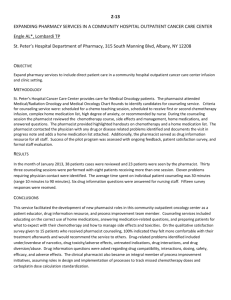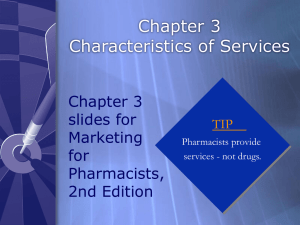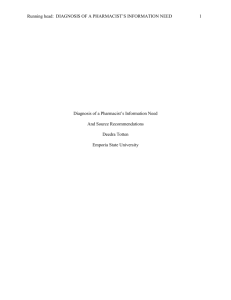Pharmacy Practice PP2 2014 OTC related conversation Feedback
advertisement
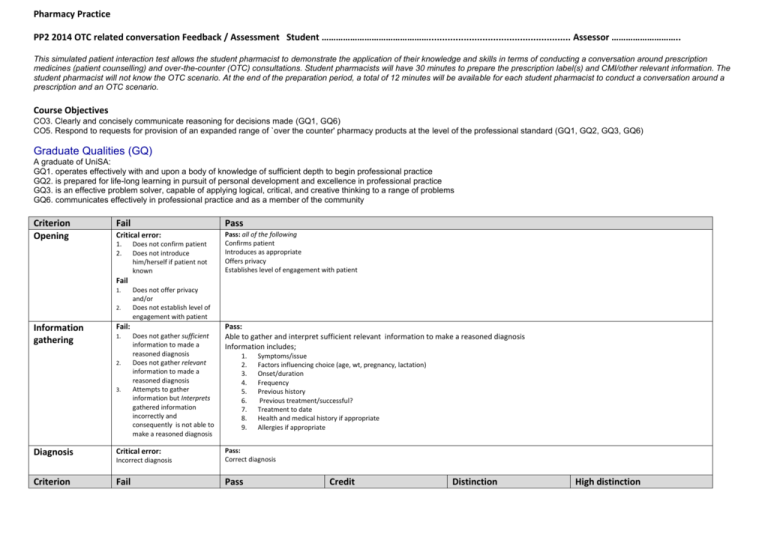
Pharmacy Practice PP2 2014 OTC related conversation Feedback / Assessment Student ………………………………………..................................................... Assessor ……………………….. This simulated patient interaction test allows the student pharmacist to demonstrate the application of their knowledge and skills in terms of conducting a conversation around prescription medicines (patient counselling) and over-the-counter (OTC) consultations. Student pharmacists will have 30 minutes to prepare the prescription label(s) and CMI/other relevant information. The student pharmacist will not know the OTC scenario. At the end of the preparation period, a total of 12 minutes will be available for each student pharmacist to conduct a conversation around a prescription and an OTC scenario. Course Objectives CO3. Clearly and concisely communicate reasoning for decisions made (GQ1, GQ6) CO5. Respond to requests for provision of an expanded range of `over the counter' pharmacy products at the level of the professional standard (GQ1, GQ2, GQ3, GQ6) Graduate Qualities (GQ) A graduate of UniSA: GQ1. operates effectively with and upon a body of knowledge of sufficient depth to begin professional practice GQ2. is prepared for life-long learning in pursuit of personal development and excellence in professional practice GQ3. is an effective problem solver, capable of applying logical, critical, and creative thinking to a range of problems GQ6. communicates effectively in professional practice and as a member of the community Criterion Opening Fail Pass Critical error: 1. 2. Does not confirm patient Does not introduce him/herself if patient not known Pass: all of the following Confirms patient Introduces as appropriate Offers privacy Establishes level of engagement with patient Fail 1. 2. Information gathering Does not offer privacy and/or Does not establish level of engagement with patient Fail: 1. 2. 3. Does not gather sufficient information to made a reasoned diagnosis Does not gather relevant information to made a reasoned diagnosis Attempts to gather information but Interprets gathered information incorrectly and consequently is not able to make a reasoned diagnosis Pass: Able to gather and interpret sufficient relevant information to make a reasoned diagnosis Information includes; 1. 2. 3. 4. 5. 6. 7. 8. 9. Symptoms/issue Factors influencing choice (age, wt, pregnancy, lactation) Onset/duration Frequency Previous history Previous treatment/successful? Treatment to date Health and medical history if appropriate Allergies if appropriate Diagnosis Critical error: Incorrect diagnosis Pass: Correct diagnosis Criterion Fail Pass Credit Distinction High distinction Provision of care plan including recommendations and advice Notes “Directions*” includes demonstrating of use of product eg inhaler, eye preps etc) “Check patient understanding**” includes giving opportunity for patient to ask questions, and getting verification that patient knows how to take/use medication by the patient reiterating pharmacist’s instructions Critical error Error(s) of fact Fail: 1.The care plan will not address problem identified in the diagnosis. 2.The patient does not have the necessary knowledge and skills to achieve the goals. 3.The patient is unable to evaluate the progress of their problem. The pharmacist delivers a care plan, which states the desired goals of therapy, determines an appropriate intervention that manages the identified problem and achieves the goals of therapy, and schedules a follow-up if necessary. The patient will leave the pharmacy with an understanding of the issue, have sufficient knowledge and skills to be able to undertake the intervention successfully, and is given a conditional referral to a GP. If a product is supplied, the following information and education is provided; (a) Drug name (b) Directions* (c) Expected benefits and possible side effects (d) Related health management advice (e) Conclude by summarising key points The pharmacist delivers a care plan, which states the desired goals of therapy, determines an appropriate intervention that manages the identified problem and achieves the goals of therapy, and schedules a follow-up if necessary. The patient will leave the pharmacy with an understanding of the issue, have sufficient knowledge and skills to be able to undertake the intervention successfully, and is given a conditional referral to a GP. The pharmacist negotiates a care plan which states the desired goals of therapy, determines an appropriate intervention that manages the identified problem and achieves the goals of therapy, and schedules a follow-up if necessary. The patient will leave the pharmacy with an understanding of the issue, have good knowledge and skills to be able to undertake the intervention successfully, and is given a conditional referral to a GP. If a product is supplied, the following information and education is provided; (a) Drug name (b) Directions* (c) Expected benefits and possible side effects (d) Storage/Handling instructions (e) Related health management advice (f) Check patient understanding ** (g) Conclude by summarising key points If a product is supplied, the following information and education is provided; (a) Drug name (b) Directions* (c) Expected benefits and possible side effects (d) Timeframe for follow up (e) Storage/Handling instructions (f) Related health management advice (g) Check patient understanding ** (h) Conclude by summarising key points Interactive use of relevant counselling aids Interactive use of relevant counselling aids The pharmacist negotiates a care plan, taking into account the patient’s present and potential capabilities, which states the desired goals of therapy, determines an appropriate intervention that manages the identified problem and achieves the goals of therapy, and schedules a follow-up if necessary. The patient will leave the pharmacy with a clear, unambiguous understanding of the issue, have the necessary knowledge and skills to be able to undertake the intervention successfully, and knows what to do if the problem does not improve as expected. If a product is supplied, the following information and education is provided; (a) Drug name (b) Directions* (c) Expected benefits and possible side effects (d) Timeframe for follow up (e) Storage/Handling instructions (f) Related health management advice (g) Check patient understanding ** (h) Conclude by summarising key points Interactive use of relevant counselling aids Relevant counselling aid provided to patient, but not used interactively Criterion Communication skills (P/F) Fail Pass Failure to satisfy all of these criteria as the patient struggles to follow or understand the pharmacist or the approach used by the pharmacist is confusing (a) (b) (c) (d) Methodical approach used (See PP1) Listens and understands all statements Speaking; articulation (vocal expression), pronunciation Body language; facial expression appropriate, appropriate eye contact maintained, nodding and verbal cues used appropriately to signal understanding Student Pharmacist to complete this feedback form and present it to the assessor immediately following the completion of the interaction Student Pharmacist-assessor conversation summary: Time taken for interaction: minutes) Student reflection - answer the following questions after the conversation with your assessor: What do you think was the outcome of your care for this patient? Comments What areas did I do well in? Why did I make errors/lose marks? What could have happened to this patient because of errors I made? What will I do differently next time? *With grateful thanks to Dr Geoff March for the original task of which this is an adaptation.
